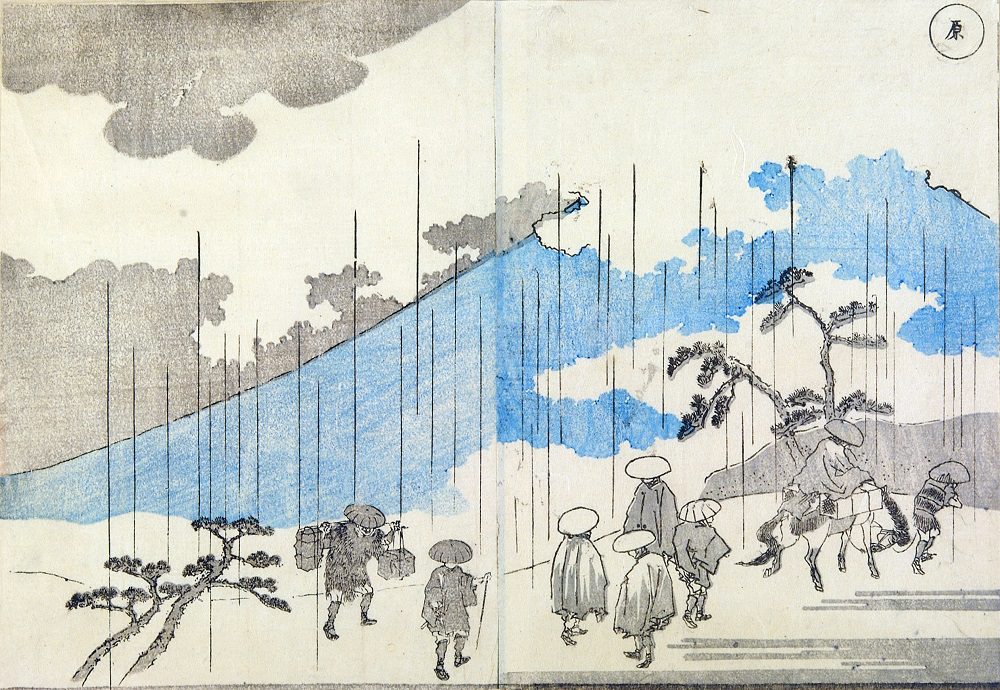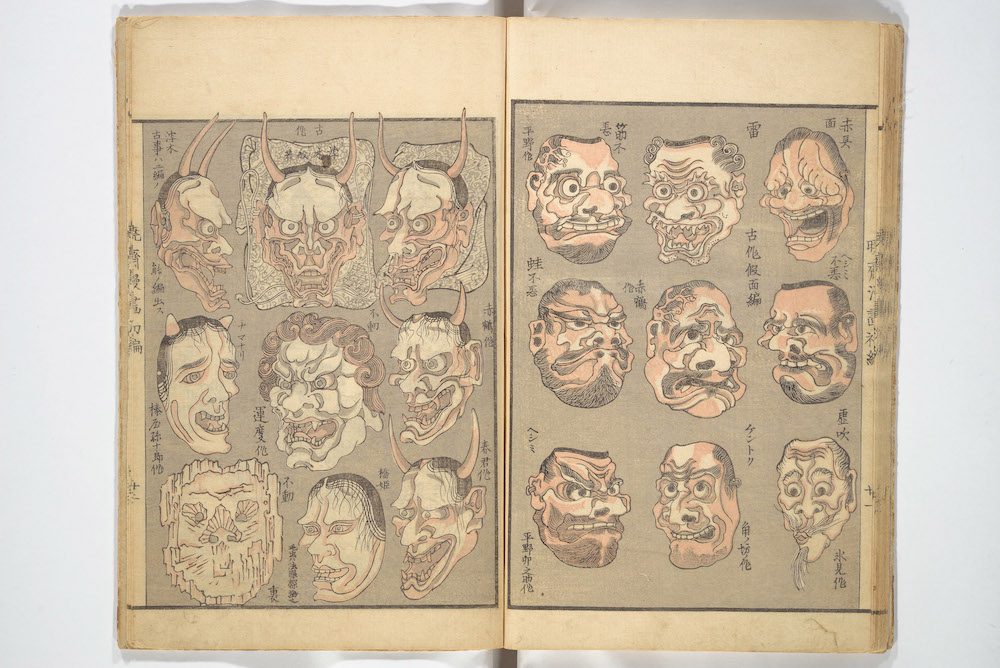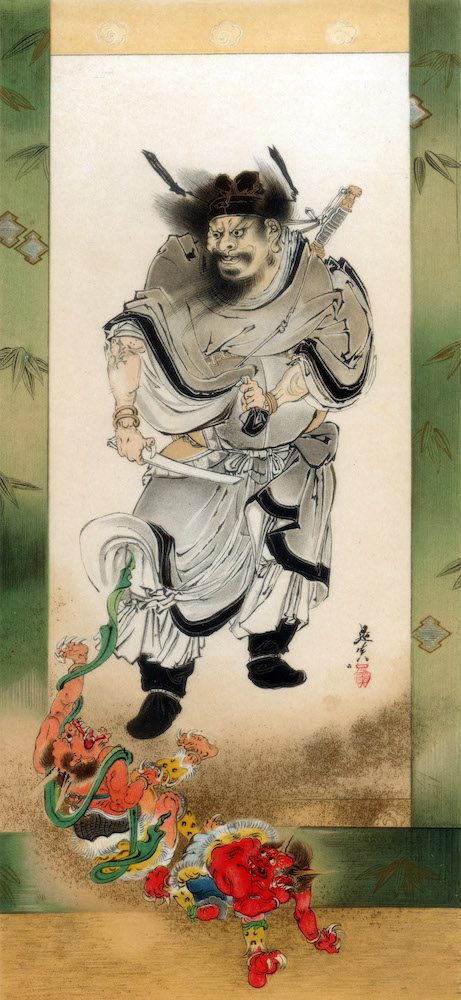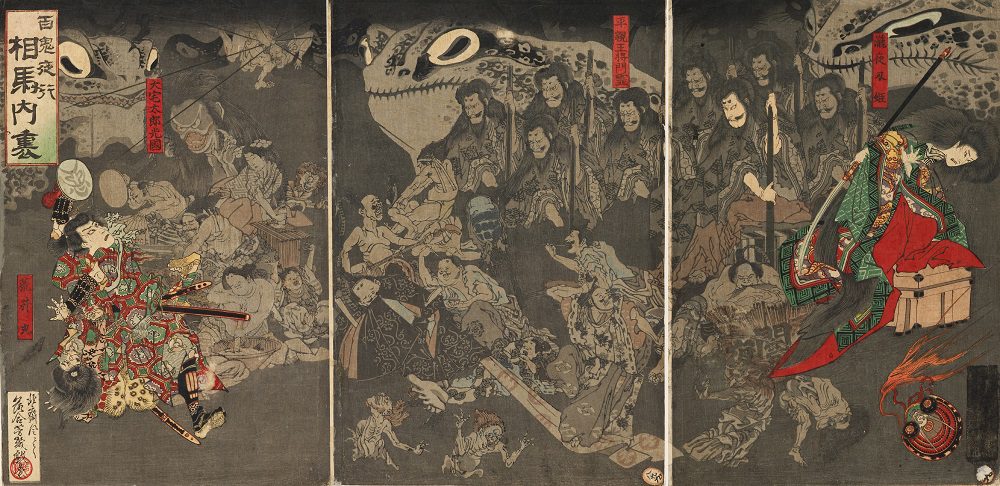
Halloween night is approaching!
Join us in discovering the enigmatic Yōkai and their legendary tales, celebrated all across Japan, with stunning images from Scala Archives. Through esteemed international collaborations with museums and photographic archives worldwide, Scala will take you on a vibrant journey of visuals featuring these mystical beings, believed to have originated over a thousand years ago in rural Japanese villages.
Yōkai (which combine the words “yō,” meaning witchcraft, and “kai,” meaning mysterious apparition) are dark creatures rooted in Japanese tradition. The Kojien, one of the most respected Japanese dictionaries, defines Yōkai as a strange creature or phenomenon that defies human understanding—a monster.
For centuries in Japan, any unusual or obscure occurrence was often attributed to the actions of a Yōkai. This belief is so widespread and ingrained in Japanese culture that Yōkai continue to be seen as the cause of inexplicable events even today.
Yōkai exist in the line between reality and the otherworldly, often preferring solitude. Some Yōkai inhabit natural settings sacred in Shintoism, Japan’s oldest religion, such as mountains, forests, and rivers. Others choose to engage with human life, manifesting in everyday objects, like the Tsukumogami, spirits that inhabit old utensils and tools.
Yōkai are known to emerge at sunset, as daylight transitions into darkness, particularly enjoying blending into the shadows on gray and rainy days.

It is quite challenging to determine the exact number of Yōkai in Japanese culture and tradition. They are numerous and manifest in many different forms. Some Yōkai have animalistic features, while others resemble humans. Interestingly, even inanimate objects can be considered Yōkai, and some Yōkai may not have any physical appearance at all.
While Yōkai are often viewed as monsters or dark creatures, not all of them are inherently evil. You can encounter treacherous and mischievous Yōkai, as well as benign ones, which are regarded as good luck charms. Most of these creatures possess supernatural powers, which they can use for either good or evil purposes.

Oni are among the oldest Yōkai known in Japanese culture. Often depicted as strong and violent beings, they are considered the guardians of the gates of hell and the torturers of the damned.
Oni are typically represented as ogres or demons, characterized by red skin, horns, long fangs, and an iron mace that they menacingly wield.If you happen to be in Japan at the beginning of February, you can enjoy the celebrations of Setsubun, also known as Risshun, which marks the day before winter turns to spring. During Setsubun, many homes are decorated with dried fish heads and holly branches to ward off the dangerous Oni.
In modern culture, Oni have become the protagonists of children’s stories, often portrayed as devourers of innocents.

The Oni, as evil figures, are closely linked to Shoki, the demon hunter. Traditionally regarded as a heroic figure, Shoki wields a sword that symbolizes his ability to vanquish evil. In contrast, the Oni are often depicted as formidable adversaries who embody chaos and malevolence, which makes Shoki’s role even more crucial in maintaining balance and harmony. The relationship between Shoki and the Oni underscores the eternal struggle between good and evil in Japanese narratives, where the courage of a single hero can triumph over the darkness that threatens the world. This reinforces the cultural belief in the power of righteousness and protection against spiritual harm.

Tanuki are among the most popular Yōkai in Japan. They are creatures capable of shapeshifting, taking on human appearances as well as the forms of everyday objects. Although they are often depicted as sinister and evil beings, some of their more comic traits are highlighted in art and folklore. For example, their large testicles are sometimes portrayed as shoulder bags or drums, and at other times, they become sails for boats or cloaks for rain.
Tanuki have inspired many Japanese proverbs. For instance, the saying “Toranu tanuki no kawazanyou,” which refers to dealing with tanuki leather that hasn’t been caught, has the same meaning as the English phrase “don’t count your chickens before they hatch.” Another saying, “tanuki no neiri,” describes someone pretending to be asleep to avoid an unpleasant situation.
Tanuki are now considered good luck charms, particularly in commercial activities and business. It’s common to see tanuki statues at the entrances of shops and restaurants, easily recognizable by their raccoon-like faces and large bellies, along with their distinctive large testicles. Additionally, many Japanese temples are dedicated to Tanuki, reflecting their significance in the culture.
The Tengu, whose legend most likely originated in China, are mystical beings that inhabit the deep mountains, where they serve as guardians. They are incredibly agile and can often be seen whispering, laughing, playing drums, and, at times, spreading fear among those who encounter them.
Known for their capricious nature, they can be both friendly and affectionate, yet also mischievous and even malevolent. Their nature leads them to play elaborate pranks, which can include setting fire to villages, kidnapping children, and, although rarely, even eating people.
Tengu are typically depicted as bird-like men or raven-demons, easily recognized by their prominent noses, which may resemble beaks. They often have wings on their heads and striking red hair. Their faces can vary in color, appearing red, green, or black, while their ears and hair usually look human.
The Tsukumogami are some of the most famous Yōkai in Japan. They are every day objects that come to life and transform into Yōkai. According to legend, this transformation occurs every 100 years. The resulting spirit can become either friendly or evil, depending on how the object was treated. If an object has been mistreated, abandoned, or discarded, it is more likely to become an evil spirit. A popular legend tells of a significant cleaning event in Kyoto around the year 1000, during which many objects were thrown away. These objects, offended by the mistreatment, are said to have marched through the streets, seeking revenge on the people who discarded them.
Even today, in some parts of Japan, people still take old or damaged objects to a shrine to give them a peaceful goodbye and protect them from becoming an evil Yōkai.
Ichijo Hyakki Yakou, or the “Parade of a Hundred Demons,” is a festival in Japan that takes place at the end of October, just before Halloween.
During this event, people dress up as Yōkai and walk through the streets. The parade has its roots in a legend from around the year 1000, about supernatural beings leaving their realm and walking through the streets of Kyoto, causing fear and panic. Today, Ichijo Hyakki Yakou celebrates this history and mixes traditional stories with fun activities, making it a lively and special event in Japanese culture.

Two late 19th century artists provide us with contrasting interpretations of this folkloric parade. Explore the stunning Kawanabe Kyōsai’s ‘Night Parade of One Hundred Demons,‘ a vibrant piece that portrays Hyakki Yakou, combining humour and satire in beautiful woodblock prints. On the other hand, Tachibana Gadō’s work presents Hyakki Yakou in a more poetic and contemplative vision. Through delicate compositions and a skilful use of colours, Gadō highlights the harmony between humans and the spirits, evoking a feeling of wonder and reflection.
The animated film Pompoko by Studio Ghibli is a great example of how the Night Parade of 100 Demons continues to be alive in the Japanese popular culture. In the film, in fact, the night parade is shown and made up exclusively of tanuki.
In Scala Archives, you will find numerous images of works by Japanese artists such as Utagawa Kuniyoshi, Utagawa Yoshiiku, Kawanabe Kyosai — talented creators who have beautifully illustrated scenes where Yōkai unleash their powers, bringing these mythical beings to life.
The images selected for this blog post dedicated to Japanese Yōkai come from the most prestigious museums in the world, including the British Museum, Victoria and Albert Museum, Museum of Fine Arts of Boston to name just a few.
With the Yōkai images available in the Scala Archives, you can create editorial works, films, and documentaries, as well as enhance your brand’s online and offline communication, and much more. We are here to help bring your projects to life!
Contact us to find the right image and discuss the most suitable license for your creative project, or explore the services offered by Scala Archives by visiting our website.
****